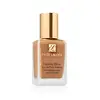Estée Lauder Double Wear Stay-in-Place Foundation Versus Kylie Cosmetics Power Plush Longwear Foundation
What's inside
What's inside
 Key Ingredients
Key Ingredients

 Benefits
Benefits

 Concerns
Concerns

 Ingredients Side-by-side
Ingredients Side-by-side

Titanium Dioxide 1%
Cosmetic ColorantWater
Skin ConditioningCyclopentasiloxane
EmollientTrimethylsiloxysilicate
EmollientButylene Glycol
HumectantTribehenin
EmollientPEG/PPG-20/20 Dimethicone
EmulsifyingSorbitan Sesquioleate
EmulsifyingMagnesium Sulfate
Tocopheryl Acetate
AntioxidantPhenyl Trimethicone
Skin ConditioningPolymethylsilsesquioxane
Methicone
EmollientLaureth-7
EmulsifyingXanthan Gum
EmulsifyingAlumina
AbrasiveBHT
AntioxidantSodium Dehydroacetate
PreservativeImidazolidinyl Urea
PreservativeChloroxylenol
AntimicrobialPhenoxyethanol
PreservativeIron Oxides
Mica
Cosmetic ColorantCI 77891
Cosmetic ColorantTitanium Dioxide 1%, Water, Cyclopentasiloxane, Trimethylsiloxysilicate, Butylene Glycol, Tribehenin, PEG/PPG-20/20 Dimethicone, Sorbitan Sesquioleate, Magnesium Sulfate, Tocopheryl Acetate, Phenyl Trimethicone, Polymethylsilsesquioxane, Methicone, Laureth-7, Xanthan Gum, Alumina, BHT, Sodium Dehydroacetate, Imidazolidinyl Urea, Chloroxylenol, Phenoxyethanol, Iron Oxides, Mica, CI 77891
Water
Skin ConditioningDimethicone
EmollientIsododecane
EmollientC12-15 Alkyl Benzoate
AntimicrobialCetyl PEG/PPG-10/1 Dimethicone
EmulsifyingPentylene Glycol
Skin ConditioningTrimethylsiloxysilicate
EmollientBoron Nitride
AbsorbentVinyl Dimethicone/Methicone Silsesquioxane Crosspolymer
Sodium Chloride
MaskingDimethicone/Vinyl Dimethicone Crosspolymer
Skin ConditioningMagnesium Sulfate
Sodium Benzoate
MaskingPotassium Sorbate
PreservativeSodium Dehydroacetate
PreservativeTriethoxycaprylylsilane
Disteardimonium Hectorite
StabilisingAluminum Hydroxide
EmollientC24-28 Alkyl Methicone
EmollientNiacinamide
SmoothingTocopheryl Acetate
AntioxidantLecithin
EmollientGlycerin
HumectantPropylene Carbonate
SolventCentella Asiatica Leaf Extract
Skin ConditioningTocopherol
AntioxidantAscorbyl Palmitate
AntioxidantCitric Acid
BufferingPentaerythrityl Tetra-Di-T-Butyl Hydroxyhydrocinnamate
AntioxidantCI 77891
Cosmetic ColorantIron Oxides
Water, Dimethicone, Isododecane, C12-15 Alkyl Benzoate, Cetyl PEG/PPG-10/1 Dimethicone, Pentylene Glycol, Trimethylsiloxysilicate, Boron Nitride, Vinyl Dimethicone/Methicone Silsesquioxane Crosspolymer, Sodium Chloride, Dimethicone/Vinyl Dimethicone Crosspolymer, Magnesium Sulfate, Sodium Benzoate, Potassium Sorbate, Sodium Dehydroacetate, Triethoxycaprylylsilane, Disteardimonium Hectorite, Aluminum Hydroxide, C24-28 Alkyl Methicone, Niacinamide, Tocopheryl Acetate, Lecithin, Glycerin, Propylene Carbonate, Centella Asiatica Leaf Extract, Tocopherol, Ascorbyl Palmitate, Citric Acid, Pentaerythrityl Tetra-Di-T-Butyl Hydroxyhydrocinnamate, CI 77891, Iron Oxides
Ingredients Explained
These ingredients are found in both products.
Ingredients higher up in an ingredient list are typically present in a larger amount.
Ci 77891 is a white pigment from Titanium dioxide. It is naturally found in minerals such as rutile and ilmenite.
It's main function is to add a white color to cosmetics. It can also be mixed with other colors to create different shades.
Ci 77891 is commonly found in sunscreens due to its ability to block UV rays.
Learn more about CI 77891Magnesium Sulfate is a salt. More specifically, it is an epsom salt, or the bath salt used to help relieve muscle aches.
Despite having ‘sulfate’ in the name, it isn’t a surfactant or cleansing agent like sodium lauryl sulfate. Unlike those sulfates, magnesium sulfate doesn’t have the same cleansing or foaming properties (it's simply a type of salt).
In cosmetics, Magnesium Sulfate is used to thicken a product or help dilute other solids. It is a non-reactive and non-irritating ingredient.
One study shows magnesium deficiency may lead to inflammation of the skin. Applying magnesium topically may help reduce inflammation.
You can find this ingredient in sea water or mineral deposits.
Learn more about Magnesium SulfateThis ingredient is a preservative with antimicrobial properties. It is the sodium salt of dehydroacetic acid.
It is especially effective at preventing bacterial and fungal growth in low concentrations.
Tocopheryl Acetate is AKA Vitamin E. It is an antioxidant and protects your skin from free radicals. Free radicals damage the skin by breaking down collagen.
One study found using Tocopheryl Acetate with Vitamin C decreased the number of sunburned cells.
Tocopheryl Acetate is commonly found in both skincare and dietary supplements.
Learn more about Tocopheryl AcetateThis silicone is an emollient. Emollients create a thin film on the skin to prevent moisture from escaping.
It is not soluble in water and helps increase water-resistance in products.
According to a manufacturer, it can blend seamlessly with silicone oils, such as Cyclopentasiloxane.
Learn more about TrimethylsiloxysilicateWater. It's the most common cosmetic ingredient of all. You'll usually see it at the top of ingredient lists, meaning that it makes up the largest part of the product.
So why is it so popular? Water most often acts as a solvent - this means that it helps dissolve other ingredients into the formulation.
You'll also recognize water as that liquid we all need to stay alive. If you see this, drink a glass of water. Stay hydrated!
Learn more about WaterThis ingredient is a combination of red, black, and yellow iron oxide pigments. This combination of colors is usually found in foundation, because it results in a "skin" color.